Prevalence and intensity of urinary schistosomiasis and soil-transmitted helminths among women of reproductive age in Mwaluphamba,Kwale
Samuel M.Ngui ,Joseph M.Mwangangi ,Joachim Richter ,Josephine W.Ngunjiri
1Department of Biological Sciences, University of Embu, Kenya
2Medical Entomology, Kenya Medical Research Institute (KEMRI), Center for Geographic Medicine Research Coast Kilifi, Kenya
3Institute of International Health, Global Health Center, Charité University Medicine, Berlin, Corporate Member of Free University and Humboldt University and Berlin Institute of Health, Berlin, Germany
4Swiss Tropical and Public Health Institute, Basel, Switzerland
5Tropical and Infectious Diseases, Department of Biological sciences, University of Embu, Kenya
ABSTRACT Objective:To assess the epidemiology of urinary schistosomiasis and soil-transmitted helminthiasis among women of reproductive age in Mwaluphamba,Kwale County,Kenya.Methods:A community-based cross-sectional study design was employed to randomly sample 422 women of reproductive age(15-<50 years) from four villages in Mwaluphamba location.Stool specimens were collected and examined using the Kato-Katz method,while filtration technique was used to analyze urine specimens.Participants’ sociodemographic details were obtained using a standardized questionnaire.Results:Urinary schistosomiasis prevalence was at 4.7% (20/422,95% CI 2.8%-6.9%) while the prevalence of soil-transmitted helminthiasis infection was 4.5% (19/422,95% CI 2.6%-6.7%).The infection intensities of urinary schistosomiasis among the study participants ranged from 1 to 120 eggs/10 mL of urine with median egg count of 18.45 eggs/10 mL.The patients were diagnosed with light infection,of 56.16 egg/gram and 48.48 egg/gram for Trichuris trichiura and hookworms,respectively.Women without latrines had 15.7 times higher risk of having urinary schistosomiasis compared to those with a latrine.Similarly,use of surface water (aOR=1.0,95%CI 0.2-1.4,P=0.010) and crossing the river to go to a place (aOR=1.1,95% CI 0.3-1.6,P=0.009) were statistically significant risk factors for getting urinary schistosomiasis.In bivariable regression analysis,defecating around the water source (OR=4.3,95% CI 1.5-12.9) had a statistically significant association with the prevalence of soiltransmitted helminthiasis (P=0.008).Conclusions:This study has given an insight on the prevalence and intensity of urinary schistosomiasis and soil-transmitted helminthiasis in Mwaluphamba location that form a basis for strengthening the control and elimination programmes for these neglected tropical diseases.
KEYWORDS: Urinary schistosomiasis;Prevalence;Soiltransmitted helminths;Mwaluphamba
1.Introduction
Schistosomiasis,also known as bilharzia,and soil-transmitted helminth (STH) infections [including hookworms,Ascaris(A.)lumbricoides,andTrichuris(T.)trichiura] are the most common parasitic infections in the world[1].Globally,around 2 billion people are suffering infections of either one STH species.The World Health Organization (WHO) estimates that approximately 819 million people are infected withAscaris,464 million withTrichuris,and 438 million with hookworms[2].Schistosomiasis is caused bySchistosomaspecies,and it’s relatively common globally,particularly in developing countries.Humans are usually infected by fiveSchistosomaspecies such asSchistosoma(S.)mansoni,S.haematobium,S.japonicum,S.mekongi,andS.intercalatum;however,S.mansoniandS.haematobiumare the most common species in Sub-Saharan African region[3].Based on the recent estimates,779 million people are at risk of infection,with Africa accounting for 85% of them.Approximately 207 million people in 74 countries are infected by these species,and 120 million of them develop the disease[4].In Sub-Saharan Africa,schistosomiasis is responsible for over 200 000 annual deaths[5].Helminthic infections are related to a variety of social,environmental,and other causes,including lack of basic health-promoting skills,overcrowding,poor access to safe water,tropical climate,and low altitude[6].
Schistosomiasis and STH are prevalent diseases in Kenya,where schistosomiasis affects an estimated 6 million people,the majority of whom are women and children;whereas STH affects 10 million people[7].Schistosomiasis is caused bySchistosomaparasites,withS.mansoniandS.haematobiumbeing the common species responsible for intestinal and urinary schistosomiasis,respectively.It is endemic in areas with freshwater bodies,including regions within Nyanza,Western,Coast,and Rift Valley provinces.In contrast,STH,caused by various soil-transmitted helminths,particularlyA.lumbricoides,T.trichiuraand hookworms affects numerous Kenyan communities,especially in rural and impoverished areas[8].Kenya has been running a National School-Based Deworming program since 2012,which involves treating all school-aged children for STH and schistosomiasis in all primary schools in 28 endemic counties dispersed throughout different parts of Kenya through an Mass Drug Administration program[9,10].A rigorous monitoring and evaluation program has been used to closely monitor the program's effect on parasitological outcomes in the treated children.The first five years of the monitoring were carried out between 2012 and 2017[11].However,it is typically understood that the impact of such a largescale national program is affected by a variety of factors,some of which are beyond the program's control[12].Furthermore,it has been demonstrated that the availability of water,sanitation,and hygiene(WASH),as well as related practices and behaviours,affect the frequency of exposure to infectious materials in the environment(such as ova and larvae)[13].
The coastal strip in Kenya is hyper-endemic for urinary schistosomiasis but with substantial spatial and temporal differences[14].Impoverished rural communities are more prone to schistosomiasis,especially areas where fishing and agriculture are the main economic activities.In the male and female urinary systems,untreated urinary schistosomiasis infection may cause painful urination,haematuria,and inflammatory and granulomatous lesions[15].A patient suffering from acute schistosomiasis normally recovers within weeks,and the worms begin laying eggs around 5-7 weeks after the initial infection,resulting in the chronic stage of schistosomiasis.Female genital schistosomiasis is a chronic infection that results fromS.haematobiumand it’s characterised by a wide range of gynaecological symptoms and signs in women[16].Grainy and homogeneous yellow sandy patches,and rubbery papules are all clinical features of female genital schistosomiasis[17].Female genital schistosomiasis,if not treated can result in infertility,miscarriages,ectopic pregnancies,abortions,stigmatization,nodules around the vulva,and the genital lesions[18].Several epidemiological studies have shown that female genital schistosomiasis is responsible for horizontal transmission of HIV/AIDS among women of reproductive age[19],while a regression analysis of prevalence ofS.haematobiuminfection and HIV in Sub-Saharan African countries found out that eachS.haematobiuminfection per 100 individuals resulted in a 3%relative increase in HIV prevalence[20].
The primary causes of STH includeA.lumbricoides,T.trichiura(ingestion of eggs from contaminated soil) and hookworms which are caused by larval penetration into the skin[21].Mature worms can live for years and produce many eggs in 4-6 weeks.Depending on the environmental conditions,STH ova and larvae may survive in the soil for a couple of months[22].STH infections are capable of causing harm to both bodily growth and development,mental activity,verbal and cognitive abilities[23].Urinary schistosomiasis and geohelminths are health issues in the rural parts of Kwale County,Coastal Kenya.In June 2012,the study also found a significant rise inSchistosomainfection among school going children,from 15.4 to 29.9 percent,and this was after a six-month survey after deworming[24].Adult infections are far less targeted compared to children[25].Despite all possible consequences of these infections among women of reproductive age,this group has remained understudied and neglected in many endemic regions of the world,with most control programs focusing on school aged children.This study sought to assess the epidemiology of urinary schistosomiasis and soiltransmitted helminthiasis among women of reproductive age in Kwale County,Kenya.
2.Materials and methods
2.1.Study area
The study was conducted in Kwale County,in Coast Province.The County is located in Kenya's south-east corner,to the south is Tanzania while Indian Ocean to the east (3.558°S-4.675°S,38.452°E-39.663°E).The county has an area of 8 295 km2²and a population of 866 820 people (Kenya National Bureau of Statistics,2019).The county experiences an annual monsoon climate,which is hot and dry from January to April and coolest from June to August.The average temperature in the county is 24.2 ℃ which favours the high release of cercarial into the waters.The county has an annual rainfall ranging from 400 to 1 680 mm.Most inhabitants are subsistence farmers.Snails,the intermediate host of schistosomiasis,breed well in the arid regions,where there are many dams and seasonal streams,a case in Kwale County.Matuga sub-county which is among the five sub-counties in the Kwale County was the focus of the study.Sampling was done in four randomly selected villages from Mkongani ward,namely,Pengo,Mwele,Kibarani A and Kibarani B.The population in Matuga is approximately 194 250 people comprising of 95 831 and 98 419 males and females respectively.The sub-county covers a land area of approximately 1 032.4 square kilometres[26].
2.2.Study design and study population
The study was carried out from April 2022 to July 2022.A community-based cross-sectional study design was employed[27],in which urine and stool samples were collected and examined to determine the prevalence and intensity of urinary schistosomiasis and soil transmitted helminthiasis among women of reproductive age from the four selected villages.All women of reproductive age (15-<50) years constituted the study population and were regarded as the target group.
2.3.Sample size determination
The sample size was determined using Fishers formula for prevalence studies[28] by assuming the estimate prevalence of 45%found during a study[29] which was done by where prevalence of urinary schistosomiasis was found to range between 0 and 91.3%among school children.
WhereN=minimum sample size,Z=Standard normal deviation 95% confidence interval (1.96),P=Estimated prevalence of schistosomiasis which is averaged at 45%,that is 0.45,D=Degree of precision (5%,that is 0.05).The sample size is therefore given as:
A total of 422 study subjects were chosen at random after being proportionally assigned to each village.
2.4.Inclusion and exclusion criteria
All female residents aged 15-<50 years were invited to participate in the study and those who consented were enrolled in the study.All below and above the age bracket and the pregnant women were excluded in the study.
2.5.Sample collection
Respondents were given two labelled stool and urine containers bearing the subjects' specific identification code and asked to fill them with approximately 4 g of stool and 30 mL of urine.Urine specimen was collected between 10:00 am and 2:00 pm,a convenient time for peak production of eggs byS.haematobium[29].Stool and urine samples were kept separately in cool boxes and immediately transported to the Mkongani health centre laboratory for parasitological analysis.
2.6.Urine examination
The urine analysis was done using the filtration technique and the urine test strip (dipstick).Upon arrival at the laboratory,the urine samples were immediately tested for haematuria,proteinuria and leukocyturia using urine reagent strips.
Using the urine filtration process,ten millilitres (10 mL) of each individual's urine sample was filtered through a 12 micron-pore polycarbonate filter and analysed microscopically.Intensity of schistosomiasis infection was determined using mean egg loads and intensities classified as: light infection (1-49 eggs/10 mL of sample)and heavy infection (≥50 eggs/10 mL of sample).
2.7.Stool examination
Stool samples were analysed within 5 hours of collection from the participants.Each sample was processed using a double Kato-Katz technique[30].Two microscope slides per stool were prepared using standard template.To obtain the number of eggs per gram,the counted eggs were multiplied using a standard conversion factor[24].Hookworm infection was classified as light [(1-1 999 egg per gram(EPG)],moderate (2 000-3 999 EPG) and heavy (≥4 000 EPG).T.trichiurainfection classified as light (1-999 EPG),moderate (1 000-9 999 EPG) and heavy (≥1 000 EPG) whileA.lumbricoidesinfection classified as light (1-4 999 EPG),moderate (5 000-49 999 EPG) and heavy (≥50 000 EPG) guidelines by the WHO[31].
2.8.Questionnaire
A pre-tested standardized questionnaire was provided to respondents in the study area to collect socio-demographic data and WASH practices.The questionnaire had unique identification codes to ensure consistency with the collected samples.Trained personnel verbally interviewed respondents and filled responses where applicable.
2.9.Quality control
Prior to data collection,the questionnaire and other materials were pretested.Laboratory examinations were performed under the supervision of experienced medical laboratory technologists.
2.10.Ethical consideration
Ethical clearance to carry out the research was sought from Kenyatta National Hospital Institutional review board(P453/06/2021).Permission to carry out the study in the community was obtained from Kwale County Department of Health REF NO:KWL/6/5/CEC/39/VOL.1/45.
2.11.Data management and analysis
The data was entered in Microsoft spreadsheet for analysis using SPSS statistical software,version 25.0.Descriptive statistics including frequency percentages,median and range was used to summarise demographic characteristics of the study participants.The proportion of infected individuals was calculated within the study participants.Intensity level was graded into light,moderate and heavy categories for STH whereas urinary schistosomiasis intensity was graded into light (1-49 eggs/10 mL) and heavy (≥50 eggs/10 mL).Chi-square (χ²) was used to compare prevalence and sociodemographic characteristics such as age groups,education level and occupation whereas for variables whose expected frequencies were less than 5,Fisher’s exactChi-square was used.Due to the non-normality of eggs counts,the Kruskal-WallisH-test was used to compare median egg loads of two or more groups such as education level.Bivariable logistic regression analysis was performed for the association of each WASH factor with the urinary schistosomiasis and soil-transmitted helminthiasis.Candidate variables for multivariable logistic regression were selected based onP-value result during bivariable analysis (P≤0.25).P-values <0.05 were considered as statistically significant.
3.Results
3.1.Socio-demographic characteristics of the study participants
Four hundred and twenty-two participants were enrolled in the study accounting to 100% response rate.This was due to prior mobilisation of the study by Community Health Volunteers.The age of study participants ranged from 15 to 49 years.236 (55.9%) Aged 15-<20 years.260 (61.6%) Were not married while 161 (38.2%)were married.According to the level of education,280 (66.4%) had attained primary level of education,86 (20.4%) secondary education,2 (0.5%) tertiary education while 54 (12.8%) had not attended any form of training.In terms of occupation,244 (57.8%) were students while the rest were farmers 163 (38.6%),traders 12 (2.8%) and only 3 (0.7%) individuals had formal employment.Based on knowledge about urinary schistosomiasis and soil-transmitted helminthiasis,275(65.2%) had heard about urinary schistosomiasis and soil-transmitted helminthiasis,with 139 (32.9%) having no idea about urinary schistosomiasis and soil-transmitted helminthiasis.The main source of water for domestic use among the study participants was surface water 372 (88.2%) followed by standpipe 89 (21.1%),unprotected well 83 (19.7%) and borehole 39 (9.2%).Collecting water was the main reason for water contact among the study participants: 396(93.8%) followed by crossing to go to a place 354 (83.9%),washing 347 (82.2%),bathing 88 (20.9%) and lastly swimming 3 (0.7%).407(96.4%) Have latrine in their home while 15 (3.6%) have no latrine at their homes (Table 1).

Table 1.Sociodemographic characteristics of the participants (n=422).
3.2.Prevalence of urinary schistosomiasis and soiltransmitted helminthiasis
Of the 422 participants who were tested for urinary schistosomiasis,20 were positive giving an overall prevalence of 4.7% (95%CI2.8%-6.9%).The prevalence of urinary schistosomiasis was higher in Pengo (6.5%) compared to Mwele,Kibarani B and Kibarani A with the prevalence of 5.7%,4.8% and 1.9% respectively.There were no statistically significant differences observed in the prevalence of urinary schistosomiasis among the four villages (F=3.056,P=0.403).Based on the age groups,women aged 15-<20 years (15,6.4%)had the highest prevalence,followed by 20-<30 years (3,3.8%),40-<50 years (2,4.3%) whereas those aged 30-<40 years showed no infection.There was no significant difference in the prevalence of urinary schistosomiasis among the age groups (F=4.454,P=0.196).Marital status,occupation,and knowledge about urinary schistosomiasis did not show statistically significant associations with urinary schistosomiasis prevalence.However,education level was significantly associated with urinary schistosomiasis prevalence(F=7.280,P=0.049),with women having no formal education exhibiting the highest prevalence (9.3%),followed by those with primary (4.3%) and secondary (3.5%) education,while no infections were observed among those with tertiary education.
The overall prevalence of STH infection was 4.5% (19/422,95%CI2.6%-6.7%) with the hookworms (3.6%,95%CI1.9%-5.5%) being the main species,followed byT.trichiura(0.9%,95%CI0.01%-1.90%),whereasA.lumbricoidesshowed no infection.Based on the villages,Kibarani A showed a slightly high prevalence of hookworms (5.7%,6/422) followed by Mwele (3.8%),Kibarani B (2.9%) and Pengo (1.9%).There was no statistically significant difference in the prevalence of STH between the various sociodemographic characteristics except forT.trichiurathat showed a significant difference between its prevalence and knowledge about the disease (F=7.321,P=0.032).
No multiple infections ofS.haematobiumand soil-transmitted helminths were observed (Table 2).

Table 2.Prevalence of urinary schistosomiasis and soil-transmitted helminth in relation to sociodemographic characteristics [n (%)].
3.3.Prevalence of haematuria, proteinuria and leukocyturia
Table 3 represents the prevalence of three key urinary symptoms(haematuria,proteinuria,and leukocyturia) and their association withS.haematobiuminfection.Overall,29 (6.9%) individuals had haematuria,37 (8.8%) had proteinuria while 29 (6.9%) had leukocyturia.This study revealed statistically significant associations betweenS.haematobiuminfection and haematuria,proteinuria,leukocyturia (Table 3).
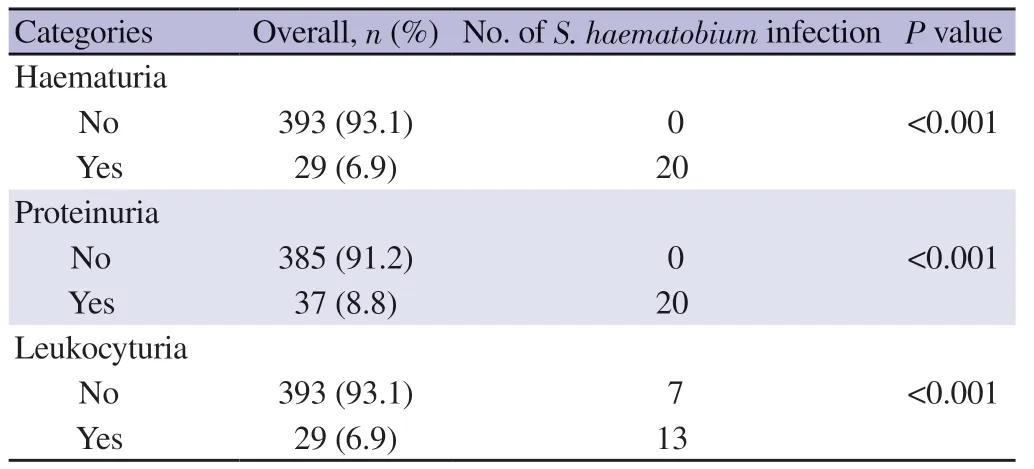
Table 3.Prevalence of haematuria,proteinuria,and leukocyturia in relation to S.haematobium infection.
3.4.Infection intensity of urinary schistosomiasis and STH among women of reproductive age
The intensity of urinary schistosomiasis among the research participants ranged from 1 to 120 eggs/10 mL of urine with a median total egg count of 18.45 eggs/10 mL.Based on the WHO categorization ofS.haematobiuminfection intensities,18 (4.3%)had light infection intensities (1-49 eggs/10 mL),while 2 (0.5%)individuals had heavy infection intensities (≥50 eggs/10 mL of urine).The parasite median egg load was high in Kibarani B (20.00 eggs/10 mL,95%CI1.00-120.00) compared to Mwele (13.50 eggs/10 mL,95%CI1.00-25.50),Pengo (9.00 eggs/10 mL,95%CI5.00-17.00) and Kibarani A (3.50 eggs/10 mL,95%CI1.00-6.00),though there were no significant differences observed (P=0.390).In terms of the age groups,those aged 20-<30 years had slightly higher median infection intensities (20.00 eggs/10 mL,95%CI15.00-60.00) compared to other age groups but the differences were also not statistically significant (P=0.079).In summary,there was no significant differences in median egg counts across villages(P=0.390),age groups (P=0.079),education level (P=0.703),occupation (P=0.741),marital status (P=0.606) and knowledge about urinary schistosomiasis (P=0.283) (Table 4).
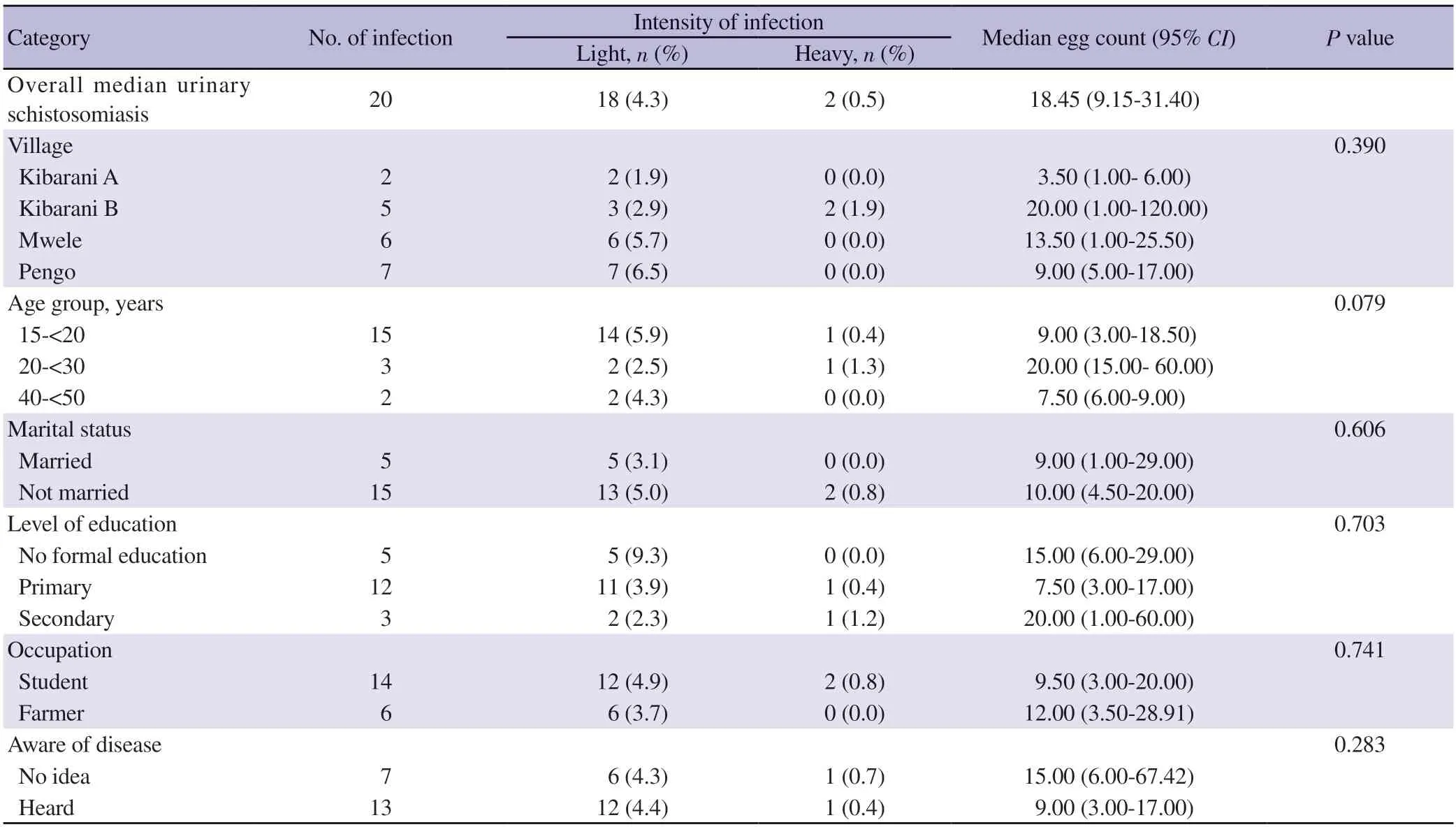
Table 4.Association between the intensity of S.haematobium and sociodemographic characteristics.
The overall geometric mean egg per gram (EPG) for STH was 56.16 egg/gram and 48.48 egg/gram forT.trichiuraand hookworms,respectively.A.lumbricoidesshowed no infection.The intensities of hookworms ranged from 24 to 960 EPG while those ofT.trichiuraranged from 24 to 144 EPG.In accordance with the WHO classification of STH infection intensities,all intensities were light with no moderate and heavy infection intensities observed.
3.5.WASH factors associated with urinary schistosomiasis and soil-transmitted helminthiasis
In the bivariable logistic regression,P≤0.25 was used for the selection of variables in the multivariable analysis.The multivariable analysis of WASH factors associated with urinary schistosomiasis revealed the groups associated with high odds of infection.Women without access to latrine showed increased risk of urinary schistosomiasis (aOR15.7,95%CI4.2-58.5,P<0.001) compared to those with latrines.Women using surface water as source of water(aOR1.0,95%CI0.2-1.4,P=0.010) showed increased risk of getting urinary schistosomiasis.Women who crossed the river to go to a place (aOR1.1,95%CI0.3-1.6,P=0.009) also showed increased risk of getting urinary schistosomiasis.On the contrary,use of stand pipe as the source of water (aOR0.0,95%CI0.0-0.3,P=0.006)showed reduced risk of being infected withS.haematobium.Lack of latrine,surface water and crossing the river to go to a place were statistically significant risk factors associated with infection withS.haematobium.Use of stand piped water was found to be protective against urinary schistosomiasis (Table 5).
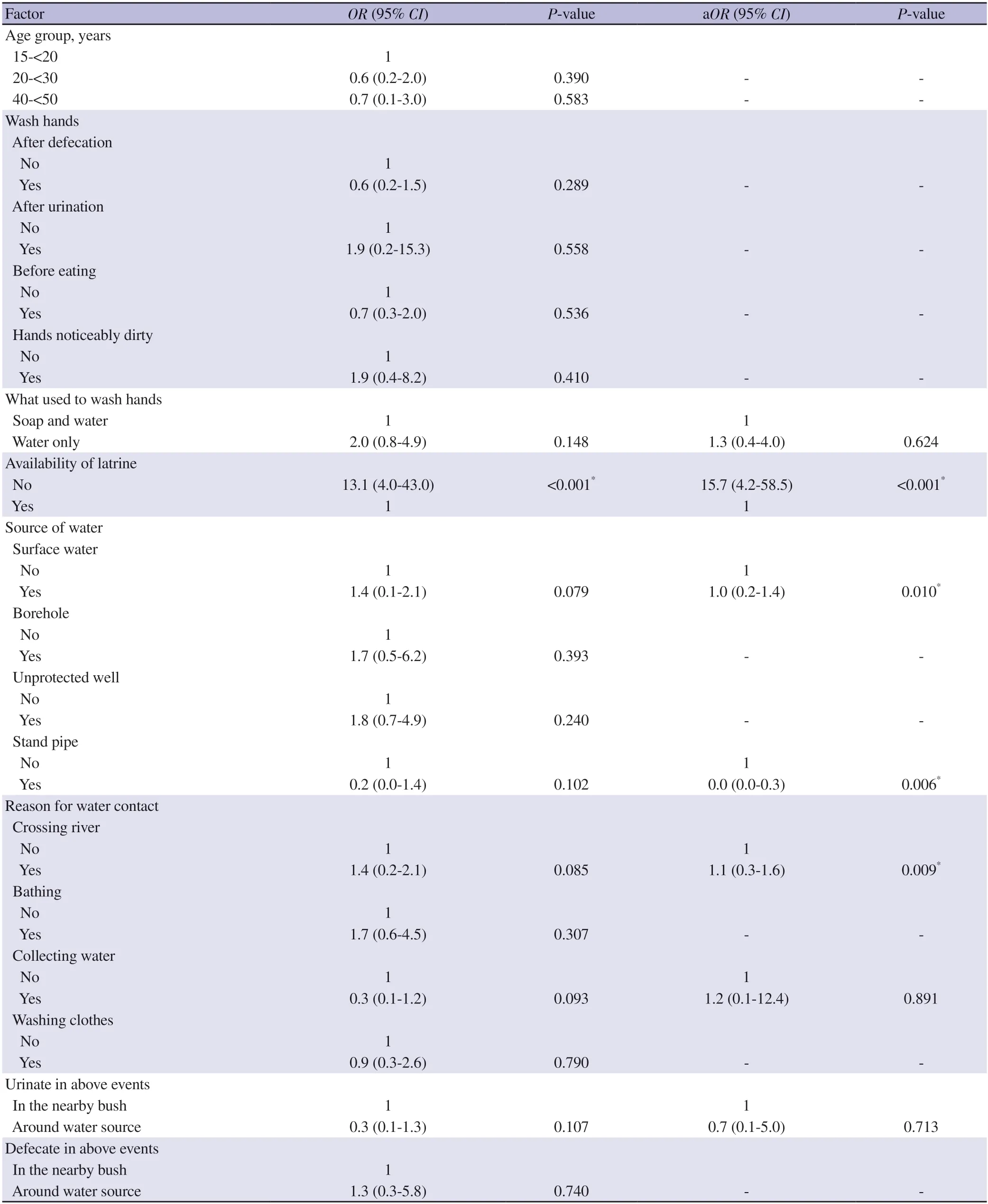
Table 5.Bivariable and multivariable logistic regression for WASH factors associated with urinary schistosomiasis.
In bivariable regression analysis,defecating around the water source (OR4.3,95%CI1.5-12.9) had a statistically significant association with the prevalence of STHs (P=0.008).However,this did not significantly predict STH infection by women of reproductive age in multivariable logistic regression.Collecting water as a reason for water contact (aOR0.2,95%CI0.0-1.0) was statistically and independently associated with reduced risk of STHs infection (P=0.045) (Table 6).
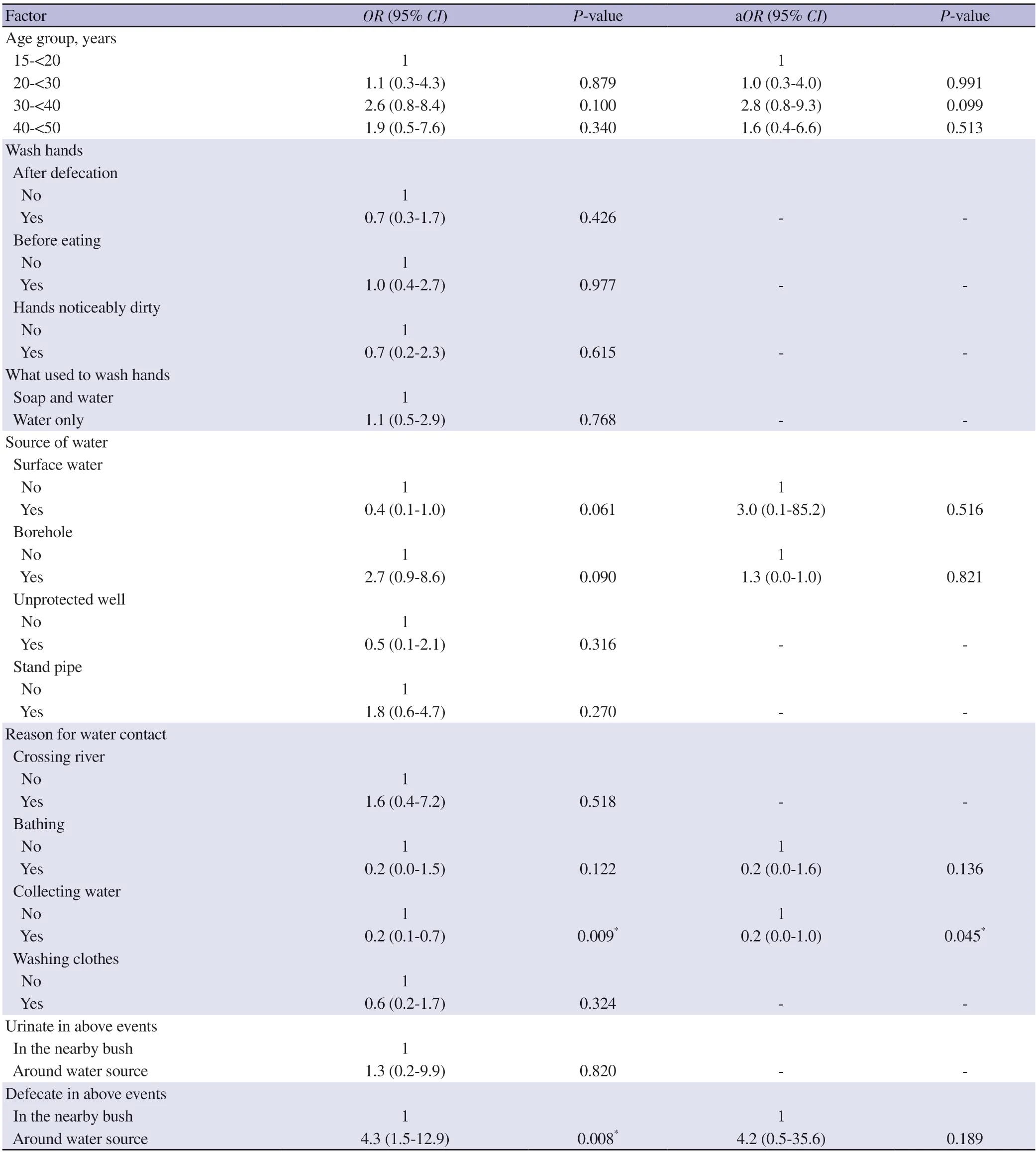
Table 6.Bivariable and multivariable logistic regression for WASH factors associated with soil-transmitted helminthiasis.
4.Discussion
Schistosomiasis and soil-transmitted helminthiasis remain a major public health issue in many developing nations among rural populations in Sub-Saharan Africa,Kenya included.The current study sought to assess the epidemiology of urinary schistosomiasis and soil-transmitted helminthiasis among women of reproductive age in Mwaluphamba,Kwale County,Kenya.The overall prevalence for urinary schistosomiasis and soil-transmitted helminthiasis among the women of reproductive age based on the sampled villages was 4.7% and 4.5%,respectively.Thus,out of the three species of STH,hookworm was the dominant followed byT.trichiurawhereas this study found no infections as a result ofA.lumbricoides.
The prevalence of urinary schistosomiasis was lower compared to a study done among people of different ages[15].The study revealed high proportions ofS.haematobiumamong the participants in the catchment areas of Mwachinga,Mwaluphamba and Bilashaka Dispensaries with 11.96%,20.96% and 22.13% prevalence of infected individuals respectively,though the catchment area of Mbuwani dispensary showed a lower prevalence of 1.13% when compared to our study.The prevalence of urinary schistosomiasis and STH in this study was also lower compared to a study conducted in selected schools in this county,where the prevalence ofS.haematobium,hookworm andT.trichiuraamong school going children was found to be 33.2%,26.1% and 1.6% respectively[32].A study done from four randomly selected villages of Bilashaka,Mwaluphamba,Mwachinga,and Dumbule reported a prevalence of 5.6% for STH,which was slightly above the STH prevalence reported during our study[7].
A study done in Mwaluphamba,Kwale County in 2011 reported a high prevalence of hookworm (41.7%) among adults[33].Since this study was done a long time ago,the drastic reduction for hookworms infection among the adults observed recently could be attributed to possible improved sanitation,health education and behavioural change coupled with improved use of toilets and water[7].Possible explanations for the reduced prevalence observed in the current study compared to earlier studies could be attributed to seasonality in schistosomiasis transmission and differences in geographical locations.The current investigation was conducted during the rainy season,which may account for the reduced prevalence observed.This is consistent to a study carried out in Southern Mauritania that showed significantly higher schistosomiasis infections during dry season as compared to rainy season[34].Low prevalence in this study could also be attributed to both school based and community based Mass Drug Administration which is usually done once every year[15].
High prevalence of urinary schistosomiasis was noted among the women aged between 15-<20 years compared to the other age groups,which agreed with the previously conducted studies in Cameroon[35,36].This may be because they are the most physically active age group and engage in the majority of outdoor activities,including swimming in contaminated water and obtaining water from rivers.This study found that surface water was the main source of water in the sampled villages hence high risk of exposure.The prevalence of hookworms andT.trichiurawas found to be high inthe age groups 30-<40 years and 40-<50 years,respectively.This was not consistent with the observation by Jezaet al.[7],in which the prevalence of STH decreases with age since our study found a variation of prevalence among the age groups.One possible explanation is regional or geographic differences in the prevalence of STH infections.Different areas may have varying levels of sanitation,hygiene practices,and exposure to contaminated soil,which can influence the transmission of these parasites.
The significant association observed between education level and urinary schistosomiasis prevalence in this study,with the highest prevalence among women with no formal education aligns with findings from several previous studies.For instance,a study by M’Braet al.reported comparable results,indicating a higher prevalence of schistosomiasis among individuals with lower educational attainment[37].This pattern could be attributed to several interconnected factors.Firstly,individuals with lower levels of education may have limited access to health education and awareness campaigns,reducing their knowledge about schistosomiasis transmission and prevention.Additionally,lowereducated individuals may be more likely to engage in activities that expose them to contaminated water sources,such as agricultural work or domestic chores,further increasing their risk of infection.
Out of 29 women of reproductive age positive for haematuria,20(69.0%) hadS.haematobiumeggs in their urine.Not all cases of haematuria tested positive forSchistosomaeggs,and this outcome is consistent with earlier investigations[38].Some cases of haematuria reported in this study were as a result of menstrual blood from some study participants.Of the 37 women that were positive for proteinuria,20 (54.1%) hadS.haematobiumeggs in their urine.The statistical significance betweenS.haematobiumand haematuria,proteinuria,leukocyturia implies that these symptoms may serve as diagnostic signs ofSchistosomainfection.A similar result was reported in Senegal[39] and Ghana[40].
The morbidity of urinary schistosomiasis is linked to the intensity of the infection[41].The study participants' infection intensities of urinary schistosomiasis ranged from 1 to 120 eggs/10 mL of urine,with an overall median egg count of 18.45 eggs/10 mL.Based on the WHO categorization ofS.haematobiuminfection intensities,the overall intensity ofS.haematobiumin this study was under light infection category,although 2 (0.5%) individuals had heavy infection intensities (≥50 eggs/10 mL of urine).The median egg count in this study was slightly lower than in a study conducted among women of reproductive age in Tanzania,which revealed a range of 8 to 38 eggs/10 mL of urine with an overall geometric mean of 19.5 eggs/10 mL of urine[42].The median egg count in this study is also considerably lower than that reported in a study carried out in Kwara state,Nigeria,where the mean egg count was 127.9 eggs/10 mL of urine[43].The differences in urinary schistosomiasis infection intensity between the studied regions can be primarily attributed to geographical variations in transmission dynamics and local water contact behaviours.Additionally,variations in the implementation and effectiveness of schistosomiasis control programs and the age distribution of the populations studied may contribute to differences in infection intensity.All cases of soil-transmitted helminthiasis among women of reproductive age in this study were light infection.This is consistent to a study done among school children in Gurage zone southern Ethiopia (January to December 30,2017),where all cases of the soil transmitted helminthes infection were with light infection,such as hookworm,Enterobius vermicularis,Taeniaspecies,A.lumbricoides,T.trichiuraandHymenolepis nana[44].
Analysis of WASH related factors show that women without latrines had higher risk of urinary schistosomiasis infection than those with a latrine.This is in accordance with a study by Sadyet al[45],which reported that lack of a latrine in the house was significantly associated with the prevalence of urinary schistosomiasis.Individuals lacking latrines in their house might have a tendency of defecating or urinating near water bodies,therefore increasing the risk of schistosome transmission.The statistically significant associations between reliance on surface water sources,and the practice of crossing rivers andS.haematobiuminfection align with findings from previous studies.For instance,a study by Mutsaka-Makuvazaet al.conducted in semi-arid areas of Makonde rural district,Zimbabwe,reported similar results,highlighting that the dependence on potentially contaminated surface water bodies were key risk factors forS.haematobiuminfection.This consistency in findings can be attributed to the fact thatS.haematobiumtransmission primarily occurs through contact with infested freshwater sources.These findings underscore the critical importance of sanitation infrastructure and access to safe water sources in preventingS.haematobiuminfection in endemic areas[46].
Use of stand pipe as the source of water was found to be protective against urinary schistosomiasis since individuals using stand pipe had reduced risk of infection.A similar finding was observed by Balenet al[47],who found that the spread of urinary schistosomiasis is positively correlated with not using a tap as a source of drinking water.This is also consistent to a study conducted in Yemen,which found that children who used unsafe sources for drinking water had significantly higher risk of having schistosomiasis when compared to those living in houses supplied with piped water[45].Stand pipe minimises water contact with the cercarial infested water bodies hence reducing the risk ofSchistosomainfection.
Collecting water as a reason for water contact had reduced risk of infection by soil-transmitted helminthiasis.This is in accordance to a systematic review and meta-analysis study which was conducted to examine the associations of improved WASH on infection with STH.The study reported that water-related access and practices were generally associated with lower risk of STH infection[48].Similar to this study,another study finding indicated that better water,sanitation and hygiene (WASH) practice has a significant reduction in the prevalence of STH,especiallyA.lumbricoidesand hookworm[49].The reduced risk of infection with collecting water in this study could be attributed to the fact that some people used stand pipes and boreholes which are less likely to be contaminated by soiltransmitted helminths.
Defecating around the water source had a statistically significant association with the prevalence of soil-transmitted helminthiasis.This is consistent to a study done in the Tiko Health District,South West Region of Cameroon,which revealed that open defecation is a risk factor for STH infections[50].This is because open defecation is suitable for parasite distribution which maximizes parasite transmission.After adjusting for the effects of confounders,the study found that use of surface water showed high risk for soil-transmitted helminthiasis infection,though this was not statistically significant.Similarly,Campbellet al.[51] found few consistent associations between access to safe water sources and STH infections in their multivariable analyses.Such inconsistencies might be attributed to the indirect nature of STH transmission through water.
The study had some limitations: the urine and stool samples were collected during rainy season,which might have underestimated the prevalence of urinary schistosomiasis and soil-transmitted helminthiasis,respectively.
In conclusion,the present study has given an insight on the prevalence and intensity of urinary schistosomiasis and soiltransmitted helminthiasis in Mwaluphamba location that form the basis for strengthening control and elimination programmes for these neglected tropical diseases.Notably,the study identified several risk factors for these infections,including the absence of latrines,reliance on surface water sources,and practices such as crossing rivers,underscoring the importance of improved sanitation infrastructure and access to safe water sources in preventive efforts.Hence,our suggestion to policymakers and relevant stakeholders is to promote the integration of deworming efforts with initiatives focused on improving water quality,hygiene,and sanitation.
Conflicts of interest statement
The authors declare that there is no conflict of interest regarding the publication of this article.
Funding
The research received no external funding.
Acknowledgments
The authors wish to acknowledge the women of reproductive age who consented to participate in the study and also the laboratory technicians: Moses Kasanga,Tsango Tsango and Salim Boga of Mkongani health centre for their cooperation and support.
Authors’contributions
S.M.N.designed the study and conducted data gathering and laboratory analysis.All authors analysed and interpreted the results.S.M.N.drafted the manuscript.J.N.,J.M.M.and J.R.critically revised the manuscript.All authors contributed to the final version of the manuscript.
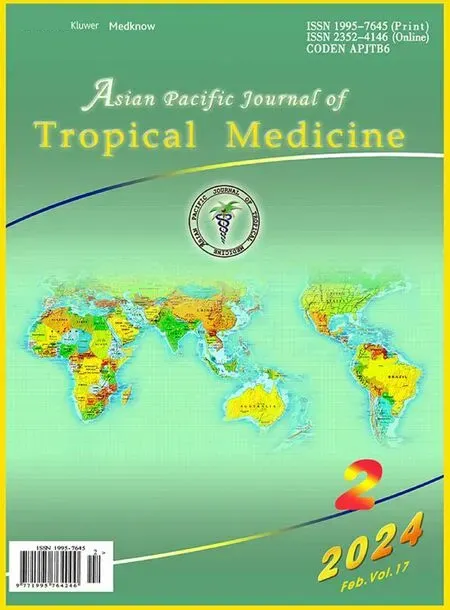 Asian Pacific Journal of Tropical Medicine2024年2期
Asian Pacific Journal of Tropical Medicine2024年2期
- Asian Pacific Journal of Tropical Medicine的其它文章
- Liposomal dual delivery systems in visceral leishmaniasis enhance the synergistic effects of combination therapy: A promise for the future
- Cardiovascular health awareness,risk perception,behavioural intention and INTERHEART risk stratification among middle-aged adults in Malaysia
- Genetic diversity of the S-type small subunit ribosomal RNA gene of Plasmodium knowlesi isolates from Sabah,Malaysian Borneo and Peninsular Malaysia
- Bilateral adrenal histoplasmosis in a Malaysian tertiary hospital: Report of four cases
